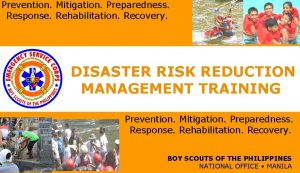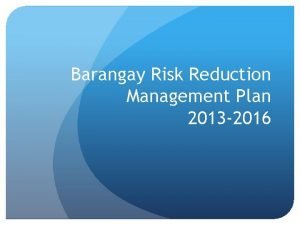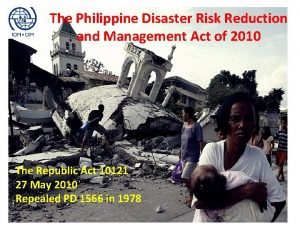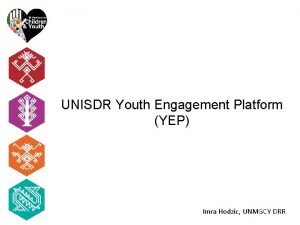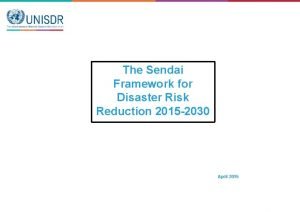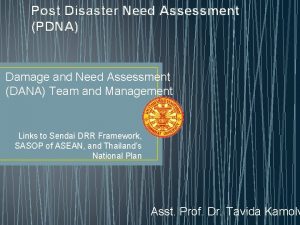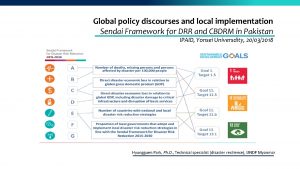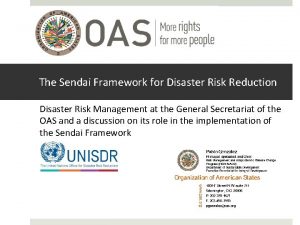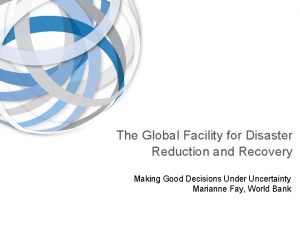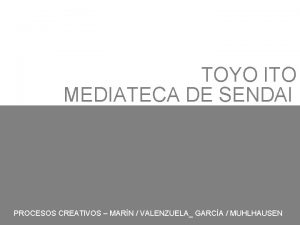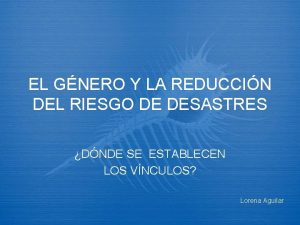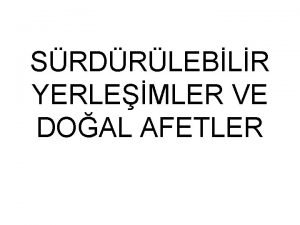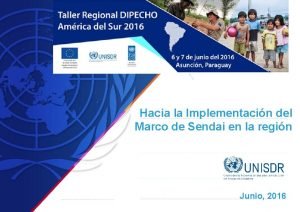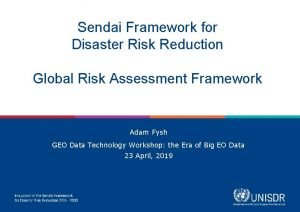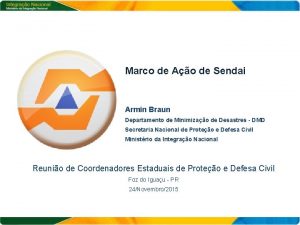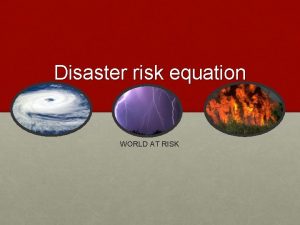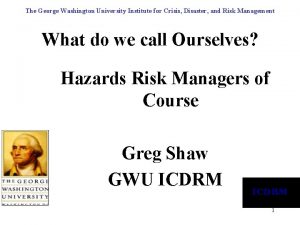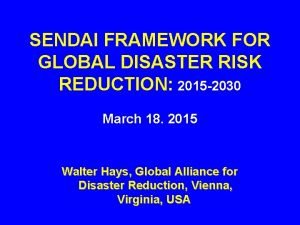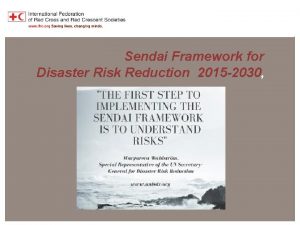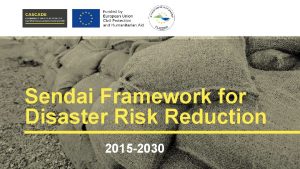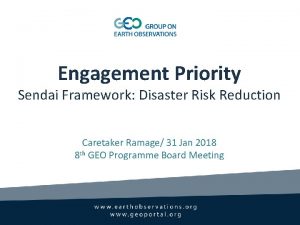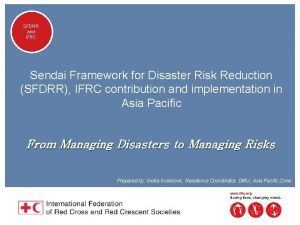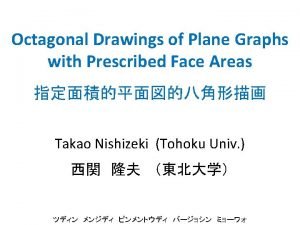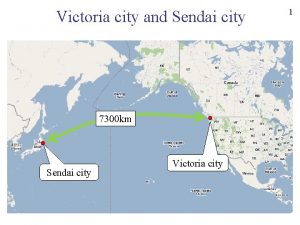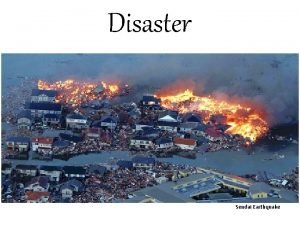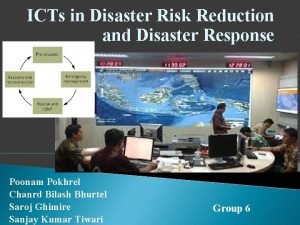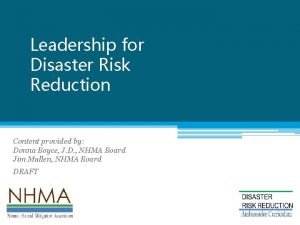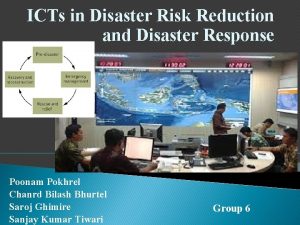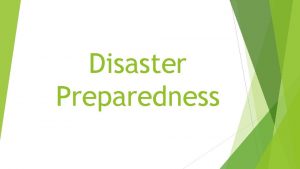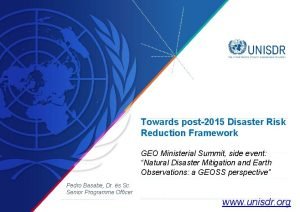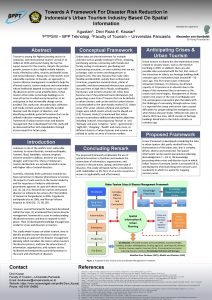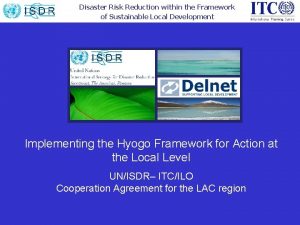The Sendai Framework for Disaster Risk Reduction 2015


















- Slides: 18

The Sendai Framework for Disaster Risk Reduction 2015 -2030 April 2015

Sendai Framework for Disaster Risk Reduction 2015 -2030 Ø Adopted on 18 March 2015 by representatives from 187 UN Member States gathered at the 3 rd World Conference on Disaster Risk Reduction (WCDRR), Sendai, Japan Ø The outcome document builds on the knowledge and experience of all stakeholders across public and private sectors. It builds on 10 years of work with the Hyogo Framework for Action and nearly three years of consultations. Today we have a practical framework that will guide our actions for the next 15 years. • Improvements from the Hyogo Framework for Action include: – – – The scope The stronger focus on risk prevention The guiding principles The seven targets The clear articulation of measures at national / local and regional / global levels – The strong mention of reconstruction and health – The role of stakeholders

Sendai Framework for Disaster Risk Reduction 2015 -2030 Overall, the Sendai Framework carries a clear: Ø Expected outcome - the substantial reduction of disaster risk and losses-, Ø Goal, Ø Seven global targets to measure progress and four priorities, and defines the Ø Scope Ø Set of principles to guide implementation Ø Section that outlines the much needed role and contribution of stakeholders. And it concludes with a very important section on international cooperation, including the role of international organisations, the UN and UNISDR.

SF Outcome & Goal EXPECTED OUTCOME - The framework aims to achieve the following outcome over the next 15 years: “The substantial reduction of disaster risk and losses in lives, livelihoods and health and in the economic, physical, social, cultural and environmental assets of persons, businesses, communities and countries” GOAL • “Prevent new and reduce existing disaster risk through the implementation of integrated and inclusive economic, structural, legal, social, health, cultural, educational, environmental, technological, political and institutional measures that prevent and reduce hazard exposure and vulnerability to disaster, increase preparedness for response and recovery, and thus strengthen resilience”

SF Scope • The SCOPE of the Framework is well defined: It will apply to the risk of: • “small-scale and large-scale, frequent and infrequent, sudden and slow-onset disasters, • caused by natural or man-made hazards as well as related environmental, technological and biological hazards and risks. • It aims to guide the multi-hazard management of disaster risk in development at all levels as well as within and across all sectors. ”

Seven Global Targets 1. Substantially reduce global disaster mortality by 2030, aiming to lower average per 100, 000 global mortality between 2020 -2030 compared to 2005 -2015. 2. Substantially reduce the number of affected people globally by 2030, aiming to lower the average global figure per 100, 000 between 2020 -2030 compared to 2005 -2015. 3. Reduce direct disaster economic loss in relation to global gross domestic product (GDP) by 2030. 4. Substantially reduce disaster damage to critical infrastructure and disruption of basic services, among them health and educational facilities, including through developing their resilience by 2030. 5. Substantially increase the number of countries with national and local disaster risk reduction strategies by 2020. 6. Substantially enhance international cooperation to developing countries through adequate and sustainable support to complement their national actions for implementation of this framework by 2030. 7. Substantially increase the availability of and access to multi-hazard early warning systems and disaster risk information and assessments to the people by 2030.

Some key guiding principles & document structure Some key guiding principles include: • • State primary responsibility to prevent and reduce disaster risk. Inclusivity. Promotion and protection of all human rights. All-of-society engagement. • The structure of the Framework identifies specific measures for national and local level, as well as regional and global level. This is to facilitate definition of responsibilities and cooperation.

Sendai Framework: Four Priorities (i) Understanding disaster risk Policies and practices for disaster risk management should be based on an understanding of disaster risk in all its dimensions of vulnerability, capacity, exposure of persons and assets, hazard characteristics and the environment. (ii) Strengthening disaster risk governance to manage disaster risk Strengthening disaster risk governance for prevention, mitigation, preparedness, response, recovery, and rehabilitation is necessary and fosters collaboration and partnership across mechanisms and institutions for the implementation of instruments relevant to disaster risk reduction and sustainable development

Sendai Framework: Four Priorities (iii) Investing in disaster risk reduction for resilience Public and private investment in disaster risk prevention and reduction through structural and non-structural measures are essential to enhance the economic, social, health and cultural resilience of persons, communities, countries and their assets, as well as the environment. (iv) Enhancing disaster preparedness for effective response, and to “Build Back Better” in recovery, rehabilitation and reconstruction There is a need to further strengthen disaster preparedness for response, take action in anticipation of events, integrate disaster risk reduction in response preparedness and that ensure capacities are in place for effective response and recovery at all levels. In addition, the recovery, rehabilitation and reconstruction phase needs to be prepared ahead of the disaster.

Sendai Framework: Key areas There also some key areas in the new framework that are worth highlighting: • Focus on the prevention of new risks, in addition to the reduction of existing disaster risk; • Importance of health in the document, role of women, human rights; • Important focus on the local: local communities, local governments, and local level action, which goes in parallel of the outlined need for a more peoplecentred preventive approach to disaster risk; • Focus on stakeholders and the importance of an inclusive approach to disaster risk reduction, with a clear articulation of responsibilities across public and private stakeholders, • Request for a full engagement of all State institutions - executive and legislative - at national and local levels; • Role of science and technology; • Critical links between international discussions / negotiations on, and implementation of, disaster risk reduction, financing for development, climate change and the post-2015 development agenda; • Focus on recovery, rehabilitation and reconstruction phase, which needs to be prepared ahead of the disaster, as a critical opportunity to build back better.

"Sustainability Starts in Sendai": Sendai Framework and the post-2015 development agenda Elements for Sendai Framework's relevance for the other post-2015 processes are the mention that: • Disaster risk reduction advances progress on sustainable development and climate change • The Sendai Framework for DRR is recognized as a key pillar/element of the post-2015 development agenda • The outcomes of the WCDRR, together with the ongoing negotiations on the post-2015 development agenda, financing for development and climate change provide the international community with a unique opportunity to enhance coherence across policies, institutions, goals, indicators and measurement systems for implementation • Ensuring credible links between these processes will contribute to building resilience and achieving the global goal to eradicate poverty

Sendai Framework: International Cooperation There is also a major section on international cooperation and global partnership, and means of implementation. With regards to the support from international organizations, the United Nations and other international and regional organizations, international and regional financial institutions and donor agencies engaged in disaster risk reduction are requested, as appropriate, to enhance the coordination of their strategies in this regard.

Sendai Declaration A brief "Sendai Declaration" was also agreed and adopted by States and called on all stakeholders to take action. • • • Recognize increasing impact of disasters and their complexity in many parts of the world, and declare their determination to enhance their efforts to strengthen DRR to reduce disaster losses of lives and assets worldwide. Values HFA, assessed and reviewed implementation experience, adopt the Sendai Framework. Strongly committed to the implementation of the new framework. Call stakeholders to action, aware that the realization of the new framework depends on our unceasing and tireless collective efforts to make the world safer from the risk of disasters in the decades to come for the benefit of the present and future generations. Thanks to Japan and Sendai.

UN Secretary-General The UN Secretary-General underscored the commitment of the UN system to support States and communities in advancing disaster risk reduction policies, based on the Sendai outcomes and to make disaster risk reduction a principal driver of the United Nations its development and humanitarian work.

Sendai Framework for Disaster Risk Reduction 2015 -2030: Commitments ü 88 commitments reported prior to the WCDRR ü More than 120 new commitments and planned actions have been made by a number of stakeholders and partners during the WCDRR Selected Examples • The science and technology community agreed to establish an international partnership of Science and Technology. • The insurance industry has pledged to double its investments in planet-smart investments to US$ 84 billion by Paris COP 21 and furthermore to increase them tenfold to US$ 420 billion by 2020.

• Japan pledged US$ 4 billion to support the implementation of the “Sendai Cooperation Initiative for Disaster Risk Reduction” over the next four years. • 23 countries have so far committed to make safe schools a priority. In particular, Turkey has vowed to make all 80, 000 of the country’s schools disaster-proof by 2018. • The private sector agreed on a set of major global initiatives (1 in 100 initiative, Planet-smart investments initiative, the Resilience Modelling and Mapping Forum). • Increased cooperation among countries, UN agencies, and civil society to invest in multi-hazard early warning systems in the context of an International Network for Multi-Hazard Early Warning Systems. • Sendai Partnership among 16 Governments, NGOs and academic institutions for understanding and reducing landslide risks, among many other valuable commitments.

Commitments from the Arab Region: ü 5 Countries have committed to implement Sendai framework for DRR: Lebanon, Morocco, Qatar, and UAE. ü Algeria has announced to provide support and share experiences with least developed countries. ü Egypt announced that it has launched a landmark project in the Egyptian capital’s Maspero Triangle district, 12, 000 people living in informal settlements will receive proper settlements and housing. Challenges related to property rights will also be taken into account and funds have also been allocated for this purpose. ü Sudan announced that it will support efforts to reduce pollution and green house gas emissions.

Commitments from the Arab Region: ü Tunisia committed to mainstream DRR into its national strategy for sustainable development. ü The UAE announced that it has setup a number of short term and long term DRR strategies that it is committed to achieve. More specifically, they include disseminating information on DRR including through the education sector, strengthen cooperation between all stakeholders, applying modern technologies to support the implementation of DRR, and to establish an information center to support this effort.
 National disaster risk reduction and management framework
National disaster risk reduction and management framework Barangay disaster risk reduction management plan
Barangay disaster risk reduction management plan Philippine disaster risk reduction and management act
Philippine disaster risk reduction and management act Yep 10
Yep 10 Priority of sendai framework
Priority of sendai framework Priority of sendai framework
Priority of sendai framework Priority of sendai framework
Priority of sendai framework Sendai framework philippines
Sendai framework philippines Risk avoidance insurance
Risk avoidance insurance Market risk assessment
Market risk assessment Global facility for disaster reduction and recovery
Global facility for disaster reduction and recovery Mediateca de sendai
Mediateca de sendai Diferencia entre el marco de hyogo y sendai
Diferencia entre el marco de hyogo y sendai Hyogo çerçeve eylem planı başlığı
Hyogo çerçeve eylem planı başlığı 7 metas globales del marco de sendai
7 metas globales del marco de sendai Global risk assessment framework
Global risk assessment framework Marco de sendai
Marco de sendai What is the disaster equation?
What is the disaster equation? Institute for crisis disaster and risk management
Institute for crisis disaster and risk management
